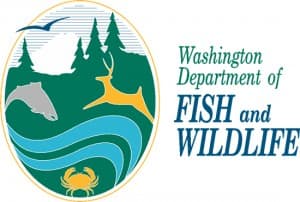Washington’s October Razor Clam Dig Approved, November Digs Tentatively Set

State shellfish managers have approved a six-day razor clam dig starting Oct. 17 and have scheduled tentative dates for additional openings in November.
The Washington Department of Fish and Wildlife (WDFW) approved the final October dig after marine toxin tests confirmed the clams are safe to eat.
The dig runs from Oct. 17-22 and begins after noon each day on the following beaches:
- Oct. 17, Thursday, 6:15 p.m.; -0.2 feet; Twin Harbors
- Oct. 18, Friday, 6:57 p.m.; -0.6 feet; Long Beach, Twin Harbors, Copalis, and Mocrocks
- Oct. 19, Saturday, 7:38 p.m.; -0.7 feet; Long Beach, Twin Harbors, Copalis, and Mocrocks
- Oct. 20, Sunday, 8:16 p.m.; -0.7 feet; Long Beach, Twin Harbors, and Mocrocks
- Oct. 21, Monday, 8:55 p.m.; -0.4 feet; Twin Harbors and Mocrocks
- Oct. 22, Tuesday, 9:34 p.m.; -0.1 feet; Twin Harbors
Dan Ayres, WDFW coastal shellfish manager, recommends diggers dress for the weather and start an hour or two before the evening low tide to achieve best results.
On days when low tide occurs after sundown, Ayres recommends diggers bring a lantern, which is much more effective for spotting clams than the direct beam of a flashlight.
Under state law, diggers can take 15 razor clams per day and are required to keep the first 15 they dig. Each digger’s clams must be kept in a separate container.
All diggers age 15 or older must have an applicable 2013-14 fishing license to harvest razor clams on any beach. Licenses, ranging from a three-day razor clam license to an annual combination fishing license, are available on WDFW’s website at https://fishhunt.dfw.wa.gov and from license vendors around the state.
The department has also tentatively scheduled additional digs Nov. 1-8 and Nov. 15-20, provided upcoming marine toxin tests show the clams are safe to eat.
“Razor clam digging is so popular and important to coastal communities that we always strive to announce tentative digs as far in advance as possible to allow folks to mark their calendars,” said Ayres. “Low-tide levels for the first tentative November dig are some of the very best we’ll have all season.”
WDFW will announce the final word on upcoming digs after marine toxin tests have been completed. Those digs are tentatively scheduled on the following dates and low tides:
- Nov. 1, Friday, 5:52 pm; 0.1 feet; Twin Harbors and Mocrocks
- Nov. 2, Saturday, 6:36 pm; -0.6 feet; Long Beach, Twin Harbors, Copalis, and Mocrocks
- Nov. 3, Sunday, 6:16 pm; -1.1 feet; Long Beach, Twin Harbors, and Mocrocks
- Nov. 4, Monday, 6:59 pm; -1.3 feet; Long Beach, Twin Harbors, and Mocrocks
- Nov. 5, Tuesday, 7:45 pm; -1.3 feet; Long Beach and Twin Harbors
- Nov. 6, Wednesday, 8:33 pm; -1.2 feet; Twin Harbors
- Nov. 7, Thursday, 9:24 pm; -1.2 feet; Twin Harbors
- Nov. 8, Friday, 10:19 pm; -0.3 feet; Twin Harbors
The dates and low tides for the second November opener follow here:
- Nov. 15, Friday, 5:01 pm; -0.3 feet; Long Beach, Twin Harbors, Copalis, and Mocrocks
- Nov. 16, Saturday, 5:42 pm; -0.6 feet; Long Beach, Twin Harbors, Copalis, and Mocrocks
- Nov. 17, Sunday, 6:20 pm; -0.7 feet; Long Beach, Twin Harbors, and Mocrocks
- Nov. 18, Monday, 6:57 pm; -0.6 feet; Twin Harbors
- Nov. 19, Tuesday, 7:33 pm; -0.4 feet; Twin Harbors
- Nov. 20, Wednesday, 8:09 pm; -0.2 feet; Twin Harbors
Comprehensive information about razor clams – from updates on tentative digs to how-to advice on digging and cooking – is available at http://wdfw.wa.gov/fishing/shellfish/razorclams/

